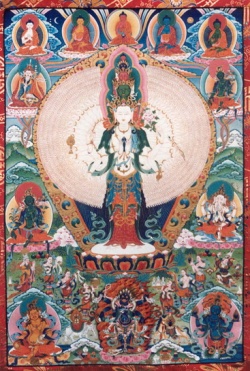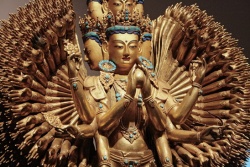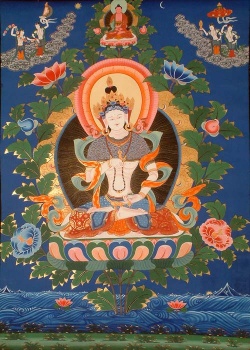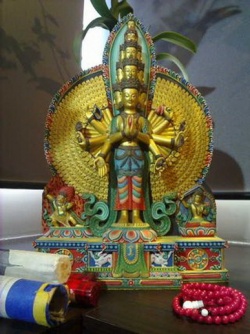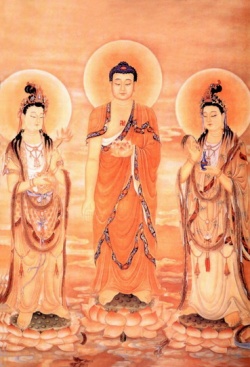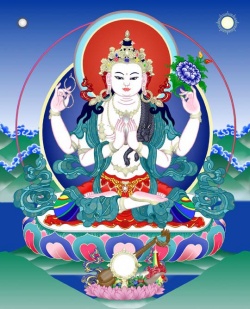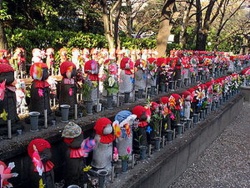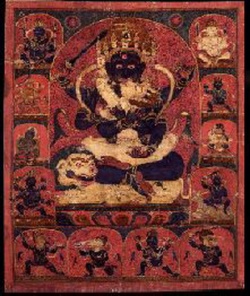Amoghpasa Lokeshvara
by Min Bahadur Shakya
1. INTRODUCTION:
Amoghapasa Lokeshvara is a multi-armed Form of Avalokiteshvara that seems to have been popular in Nepal since the Middle ages. The name suggests that he is the Lord of the World with infallible noose which leads Suffering Sentient beings to Enlightenment.
In Nepal as much as 360 forms of Avalokiteshvara are found in hymns or stavas but only 108 forms of Lokesvara can be found in pictures with iconographic details. Whit a close survey of these pictures we can tentatively conclude that' Lokeshvara' is said to be a deity or a Bodhisattva or a Buddha who vows to do welfare of all Sentient beings. Etymologically the word 'Lokeshvara' is the union of two words i.e. Loka + Ishvara= Lokeshvar i.e. the Lord of the World. Although in Buddhism the concept of inherent existence of Ishvara is denied in philosophical aspects yet in common parlance Newar Buddhists regard all Buddhas or Bodhisattvas as Lokeshvara. It seemed that those Bodhisattvas belonging to the tradition of Lokeshvaraja Tathagata are said to be lokeshvara according to Sukhavativyuha Sutra.
According to Amoghpasa Hrdya nama Dharani Sutra]], ninety on kalpas ago Avalokiteshvara Bodhisattva received the transmission of this Dharani from Lokeshvararaja Tathagata [i]. Since then he used that Dharani to teach limitless Sentient beings. When the Avaliokiteshvara manifests transformed Body and uses this Dharani to ferry over Sentient beings he is called 'Amoghpasa'.
II. Rituals:
There are a number of Rituals of Sadhana of Avalokiteshvara known among the Newar Buddhists which are performed on the Full Moon Day or Half Moon Day . These are commonly called Uposadha Vrata or Astami Vrata. However, by far the most popular, is the Uposadyha Vrata of Amoghpasa Lokeshvara. A short description of Ritual of Amoghpasa is befitting in this context [2]. A group celebration of Ritual is centered around the worship oaf the mandalas of The Buddha, Dharma and Sangha and Amoghapasa Lokeshvara. The group may gather at a temple. such as [[Hiranya Varna] Mahavihara]] or Patan, Jnanabaha of Kathmandu, Rudravarna Mahavihara or Machhendra Bahal in Patan or they may gather at the river side of one of the pilgrimage sites around Kathmandu Valley found at the confluence of rivers. There are twelve pilgrimage sites (Skt. Tirtha) [3] in the valley, the eight Vaitaraga [4} sites, Four Buddhist Stupa [5] sites, and Eight Lokeshvara sites [6] Wherever the Vrata is performed the basic Ritual is the same.
The devotees after bathing in the river put on clean Clothes and make miniature caityas (Tib. Tsa-Tsa. The Buddhist Acarya after purifying the ground will construct a sand Mandala and performs Guru Mandala rite followed by an offerings of five sacred substances (skt. pancagavya) [7]. After completing the preliminary rite the Acarya instructs them to construct the mandalas of Buddha, Dharma Sangha and Amoghpasa Lokeshvara, in a large piece of red cloth. After completing Mandala construction five fold substances are offered on the Mandala also a lamp is lit in each Mandala. Next the participants who are mostly the lay devotees are led through the Puja of The Buddha, Dharma, Sangha Mandala [8] successively. During the rite all the recitations are done in Sanskrit by the officiating Buddhist priest and the participants perform the Offering, libation and litting the lamps-as per instructions. The Ritual concludes with the taking of Refuge and eight precepts. [9]
The worship of Three Jewels is followed by Amoghpasa Madala. To begin with the participants pour holy water on Conch shell and recites a verse of praise to amoghpasa throwing rice grains into the air. The Verse runs as follows:
Suddha kunda tusarbhasa sadrsam padmevara samsthitam /
Sarvajna viddhana mahabhayaram sri pasajapottamam //
bamenapi kamandalam ca kamalam dandottanam pustakamas /
Vandeham parameshvara tusitasalokanu kampabhyam //
The verse in Translation:
"Homage to Amoghpasa Lokeshvara ! I bow my head to the Lord who is pure as white as the Jasmine flower, or as frost, standing on a Lotus, whose right hands show the gesture of fearlessness and a hold a noose and a rosary; his left hands hold a water pot, a Lotus, a staff, and a book". Next the participants are asked to meditate on Caturbrahma Vihara i. e. For Immeasurable [10] Them the participants take a jasmine flower and put it into the Mandala. After recitation of two mantras [11] the devotees meditate on Amoghpasa, thus:
"Meditate on the letter Pam residing in your Heart, the 100 petalled Lotus above the rays of which is the circle of the moon, and above that the letter hrim, and above that the one who is called Amoghpasa Lokeshvara."
After meditating on Amoghpasa the participants offers Flowers to all the deities of Mandala. [2] At the conclusion of the mandala puja the participants are asked to offer five fold Offering them lit a lamp and offer coins to the deity and recite hundred syllable Mantra of Vajrasattva followed by praise to Amoghpasa as cited above.
III. THE DEITY
Amoghpasa is popular not only in Nepal but all the countries where Mahayana Buddhism spread. The images of Amoghpasa can be found in Java, China and Japan. According to Dr. Luciano Petech, the image of Amoghpasa in its earliest from can be found in Arty Amoghpasa Sutra preserved n Kaiser Library, Kathmandu dated 2 May 1361. A Ritual text known as [[Amoghpasa Puja] vidhi]] describes him thus:
"Amoghpasa is the mystery in the center of the World Lotus; all his limbs are white; he has one face, wears the saffron dress; he has eight hands, the right showing the gesture of fearlessness (Skt. Abhaya) and the boon granting gesture (Skt. Varada), holding the noose and the string of beads, the left holding a trident, a scripture, a white Lotus and a water pot (Skt. Kamandalu). To the right of the Lord is Tara who is of green colour, with two hands, the right showing the Varada Mudra and the left holding a blue Lotus, she wears all the proper ornaments related with sambhhogakaya Buddha. On his left is Bhrikuti of yellow colour having four hands; on the right her first hand makes the varada Mudra and second [[Anjali] Mudra]]; on the left the first hand holds a coral tree flower, the second a rosary.
IV. MEANING OF THE EMBLEMS OF AMOGHPASALOKESHVARA
[
At first a thousand petalled Lotus was created or produced from seed syllable 'Yam' on the center of which appeared ]]Amoghpash Lokeshvara]] white like Conch shell from the seed syllable Hrim.
He has three divine eyes looking on triple word. His first right hands shows the gesture of fearlessness. It symbolizes that one who practices ]]Astami Vrata]] sincerely protects us from falling into lower realms.
Second right hand displaying gesture of Varada Mudra shows that those who practices Astami Vrata generating Compassion and Bodhicitta receives all desirable objects.
Third right hand holding Amoghpash or infallible nose suggests that Amoghpash Lokeshvara has infallible skill in means in converting ignorant Sentient beings in the path of Dharma.
Fourth right hand holding rosary signifies that by recitation of six syllable Mantra of Avalokiteshvara one frees oneself from the bondage of Samsara.
Again among four left hands, one principal hand holds Kamandalu i. e. a water pot signifying he has the capacity of initiating all the Sentient beings into Tathagatahood.
Second left hand holding Lotus signifies that he frees the Sentient beings residing in [[Hell] realm]] from the Suffering of intense heat and cold just like a Lotus emerges from a muddy water.
Third left hand holding triple staff (Skt. Tri-dandi) signifies that he purifies Three poisons of Sentient beings i.e. Just, ill will and stupidity.
Fourth left hand holding a scripture signifies that he gives Prajna to the devotees and thereby attaining Liberation from cyclic existence.
He is wearing an antelope skin symbolizing that he is extremely compassionate to Suffering Sentient beings.
V. LEGEND OF AMOGHPASA LOKESHVARA
Long time ago the city pancala was divided into two parts. North and south Northern Pancala was called Hastinapur where a king called Mahadhana reigned very successfully with full prosperity. Because of presence of a serpent deity called Janmacitra there was a timely rainfall and regular harvests. In the south because of King's immoral behavior to his people the prosperity of The country waned significantly and no one dared to settle in that country but in stead migrated to Northern Pancala.
One the king in course of his tour to border areas, found villages empty of people and asked his ministers, the cause, the ministers that reported to the king that it was because of his injustice and famine that people migrated to the north. Besides, it was due to the Power of a serpent deity that they have timely harvests. The king then at once decided to fetch that serpent deity to his country. Summoning a priest who was able to fetch serpent deity the king ordered him to fetch within seven days. This being known to hat serpent deity, he informed two hunters to help him to protect the serpent deity. After seven days when the priest was invoking serpent deity two hunters killed him and the Life of the serpent deity was saved. As a token of Gratitude two hunters were offered many jewels as a precious noose which is capable of securing the things which one wishes.
At that time the king Mahadhana having no sons and daughters was full of Grief. He performed Amoghpasa Vrata every eight day of Lunar months, according to the instruction of royal preceptors. Buy the Power of Uposadha Vrata of Amoghpasa Lokeshvara the queen begot a son, a manifestation of Bodhisattva of this fortunate aeon. This prince was brought up in luxurious atmosphere and was also taught many skills and royal duties. Once two hunters were roaming in the jungles and met a sage nearby. They asked the sage about the characteristics of the area. Then the sage replied that he had seen a group of beautiful divine maidens every full moon day near the lake.
Among them Mahohara, the daughter of divine Kinnara King was one. So these two hunters used their precious noose (amoghpasa) to keep this beautiful maiden princes under their control. when they were bathing in the lake. When she was touched by the noose she could not move and cried bitterly for help. When one of hunter was going to grab the princess, she requested the hunters to free her and she promised to give her headdress in return, and said that the possessor of head dress would be her Lord. In the mean time Sudhana kumar, the prince was roaming in that area for Hunting. Seeing the prince two hunters decided to offer her headdress to him. The prince Sudhana kumar came back to his palace with his divine wife manohara, after giving many presents to these hunters. Infatuated with the Beauty of Manohara, the Kinnar princess the prince seemed to have indulged in sensual pleasures for many many years.
Once the prince was sent to the border areas to suppress the terrorists. The prince had to go without informing his wife. While the prince was thus out, the king once dreamt a very bad dream. On asking the cause the king was instructed to kill Manohara in sacrificial Fire. She, knowing that she was going to be murdered by the wicked tricks of royal priests, appeared herself in the presence of queen mother to fetch her headdress which was given to her by her husband, the prince.
After taking her headdress she escaped to her divine realm. When the prince came back after a successful mission, he went directly to meet his beloved wife in his apartment but found disappointed to know that she had fled to her divine realm. Immediately, he hurried back to the sage in the forest where he had found her previously and asked where bouts of his beloved wife. Manohara, in course of her flight to her divine realm, had given instructions and a ring to this sage to retell if the prince comes to look for he.
The sate communicated him perfectly as she told. The prince Sudhana kumar with his great Zeal and efforts, after crossing many mountains and rivers arrived in the realm of Kinnars. At that time many Kinnara maidens were bathing in the streams with golden water pots. On asking the cause the kinnar maidens replied that the water in golden pot was to purify impure human odour in the person of manohara, the princess. The prince dropped then a ring in one of the water pots.
In the royal chamber of princess Manohara, the water from golden pot was poured into her. As water was poured she found a golden ring dropped on her lap. as she found her own ring which was given to the sage she came to know that her husband had arrived in the Kinnar realm. Then she instructed her maids to hide her husband in her sacred chamber. After finding a proper time she was able to convince her father Druma, the king of kinnaras, to accept Sudhan Kumar, only after examining his skills, energy, Power and Wisdom. Sudhana kumar stood successful in all difficult tests in winning his beloved wife.
He came back to Hastinapur with his beloved wife after completing Svayamvara ceremony in Kinnar realm. Since then the prince too performed many Amoghpasa Uposadha vrata until his end.
This story was told by the Buddha Shakyamuni when his wife Yasodhara fell down from the window to see the dazzling countenance of Buddha who was coming to the royal palace of Suddhodana after six long years of separation, He said that Manohara was no other that the present Yasodhara herself in her previous Life and Sudhana kumar was The Buddha himself. This story is related in detail in Divyavadana, Bhadrakalpavadana and Brhat Jatakamala.
VI. A SYNOPSIS OF AMOGHPASA HRDAYA Sutra
Thus have I heard. Once Lord Buddha was dwelling on the summit of Potalaka Mountain adorned with jeweled trees, in the palace of Arya Avalokiteshvara together with 1800 Arya Bhikshu Sanghas and more that one billion Bodhisattvas and devas of pure abode. He was giving discourses to all of them.
Then the Bodhisattva Avalokiteshvara rose from his seat and prostrated to Lord Buddha Kneeling on the ground baring his right shoulder, with folded hands and he requested thus;
"O Lord! I have a Dharani called Amoghpasa Hradaya which I received it from Lokendraraja Tahtagata ninety one aeons ago in the realm of Loka-avalokana. The special feature of this Dharani is that it purifies that evils of wrong doings of slandering Noble Bhikshu Sanghas, to Pratyeka Buddhas, Bodhisattvas, Buddhas which are the cause s of falling into lower realms such as Avici Hell. The Purification becomes effective if someone after confessing one's down-falls observes Uposadha Vrata of Amoghpasa holding eight precepts and recites this Dharani may times. Those who's recited this Dharani seven times correctly in the eighth day of lunar Calendar will receive twenty meritorious qualities.
They are as follows:
1. He will be free from any type of diseases.
2. Even if the disease appears out of Karmic causes it will disappear very soon.
3. He will be popular or liked by all.
4. HIS organs will be secret.
5. He will gain much property and possessions.
6. His property will not be stolen by thieves,
7. Not be affected by Fire,
8. Not be affected by water,
9. Cannot be confiscated by the king or government.
10. All his actions will be complete.
11. Free from 5the fears of water, with din his person.
12. Pacifies all disturbances.
13. His personality will not diminish.
14. Free from the fear of Dakinis.
15. Afflictions will no increase.
16. He will not die due to the Weapons, Fire or water.
17. The devas will take care of his person or protect him.
18. He will have loving Kindness, Compassion.
19. Joyfulness and
20. Equanimity wherever he will born.
Besides this, he will also receive eight further qualities. They are as follows:
1. When he will die he will be received by Avalokiteshvara in Monk's Form and
2. He will die comfortably
3. His arms and legs will not vibrate, he will not have wrong views.
4. His Body will not produce faces and urines,
5. no aerial trouble
6. He is endowed with awareness and alertness,
7. no decrease in memory
8. He will not die with his face downward,
9. He will not die with heavy Affliction,
10. will be born wherever he aspired to be borne, and
11. associated with kalyana mitras
One should recite it three times refraining from bad foods such as meat, liquor, onions and Garlic. One should try his best to propagate and disseminate this Dharani liberally as for as possible. One should be free from miser lines and jealousy, He will be a Bodhisattva when he performs this recitation for the cause of all Sentient beings.
O Lord! if you permit me to transmit his Dharani I will present it in the presence of Tathagata in this gathering of Sangaha composed of Bhikshus, Bhikshunis, Upsasakas and Upasikas for the sake of all the Sentient beings. Then Lord Buddha spoke thus: of Pure Being ! I this time for your to disseminate your Amoghpasa Dharani. I appreciate you, please speak it, it will satisfy all the Bodhisattvas of three divisions of time.
Then the Bodhisattva Avalokiteshvara generating his great Compassion for all Sentient beings recited Amoghpasa Hrdaya Dharani thus:
